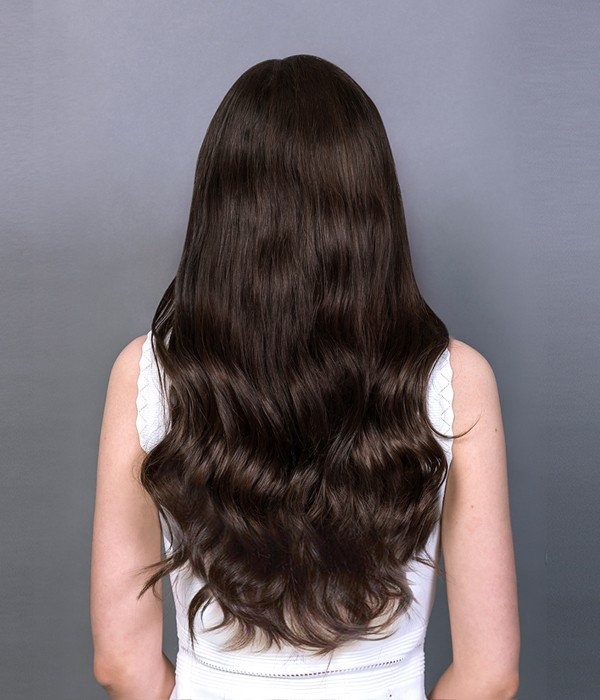Human Hair and Synthetic Fiber Hair
Jul 05,2023
When it comes to hair extensions, wigs, or weaves, it's critical to discern between human hair and synthetic fiber hair. Understanding the fundamental distinctions between the two might help you make an informed decision and get the ideal look and durability. This article will look at the qualities, benefits, and methods for distinguishing between human hair and synthetic fiber hair. This detailed guide will aid you in making the proper choice whether you are a hairdresser, a hair enthusiast, or someone considering hair extensions.


1. Appearance:
Human hair: It varies slightly in color, length, and thickness and is silky and shiny. Similar to genuine hair, each strand has its own distinct characteristics. Heat styling equipment can be used to style it, and it can even be colored or permed to achieve the desired look.
Synthetic Fiber Hair: Synthetic materials like acrylic, polyester, or modacrylic are used to make synthetic fiber hair. Despite being created to resemble real hair, it frequently lacks the natural appearance and feel. The color, texture, and length of synthetic hair are frequently uniform, giving the appearance of being fake. Additionally, it is more prone to tangling and might melt in extreme heat.

2. Heat Resistance:
Human hair: Human Hair Has Good Heat Resistance Human hair has good heat resistance, which is one of its major benefits. It is resistant to harm when exposed to high temperatures from styling appliances like curling irons and straighteners. This makes it possible to modify your hairdo whenever you want and offers a variety of styling possibilities.
Synthetic hair fibers: Hair made of synthetic fibers cannot withstand high temperatures and is not heat resistant. When exposed to heat styling equipment, the synthetic components employed in its formulation may melt, frizz, or suffer irreparable damage. Heat should never be used to synthetic hair in order to avoid permanent damage.

3. Longevity and Durability:
Human hair: Human Hair Human hair is recognized for its longevity and durability. Human hair extensions or wigs can last substantially longer than synthetic alternatives with the right upkeep and care. Human hair's inherent toughness makes it more resistant to everyday wear and tear.
Synthetic hair fibers: Hair made of synthetic materials is typically less enduring than hair made of actual hair. It has a higher propensity for matting, tangling, and shedding. Depending on usage and quality, synthetic hair extensions and wigs often have a shorter lifespan, ranging from a few months to a year.

4. Human Hair's Styling Versatility:
Human hair: Human hair's styling versatility is one of its most alluring features. It behaves like natural hair, so you may style it however you choose by curling, straightening, or any other method. This enables you to easily change up your appearance and create a more distinctive appearance.
Synthetic Fiber Hair: Due to its weak heat resistance, synthetic hair has few styling options. The shape of synthetic fiber hair is frequently pre-styled and cannot be changed without endangering the fiber. Some synthetic hair kinds are made to maintain their style even after washing, which makes them more practical for people who desire a particular look without having to restyle.


5. Maintenance and Care:
Human Hair: To keep human hair in top condition, it needs to be regularly maintained and cared for. Washing, conditioning, and styling are all included. Human hair wigs or extensions can be cared for in the same way as genuine hair, assuring longevity and a youthful, vibrant appearance.
Synthetic Fiber Hair: When compared to human hair, synthetic hair requires less maintenance. It requires less washing and styling, and the look frequently holds. To avoid matting and tangling, it is essential to adhere to the manufacturer's detailed care instructions.
6. Pricing:
Human hair: Human hair extensions or wigs are frequently more expensive than hair made of synthetic fibers. The source, quality, length, and texture of the hair are a few variables that affect the price of human hair. Human hair is regarded as a premium alternative for people looking for a more natural look and long-lasting results since it offers greater quality, durability, and styling versatility.
Synthetic Fiber Hair: In comparison to human hair, synthetic hair is typically more cheap. The brand, length, and quality of the fibers all affect how much synthetic fiber hair costs. For those on a tighter budget who like pre-styled appearances that only take minimal work or are searching for temporary or occasional use, synthetic hair offers an affordable choice.

7. Differentiating Between Human and Synthetic Hair:
Following our discussion of the qualities and distinctions between human hair and synthetic fiber hair, let's look at some techniques for determining which is which:
a) Visual Inspection: A visual inspection is one method of telling real hair from hair made of synthetic fibers. Pay great attention to the appearance, consistency, and texture of the hair strands. Natural flaws in human hair, such as modest variances in color, length, and thickness, are common. Contrarily, the look of hair made of synthetic fibers is frequently more uniform.
b) Heat Test: A heat test can assist identify if the hair is synthetic fiber hair or human hair. Apply a flat iron or curling iron to a small portion of hair using a low heat setting. It is probably human hair if it can endure heat without melting. However, it is synthetic fiber hair if it melts, frizzes, or has a bad smell.
c) Water Test: For the water test, a little sample of hair is dipped into a bowl of water. Similar to natural hair, human hair will act by absorbing water and gaining weight. Contrarily, because synthetic fiber hair does not absorb water, it usually floats or stays buoyant.
d) Burn Test: The burn test is another way to distinguish between human hair and hair made of synthetic fibers. Grab a tiny hair strand and hold it in your tweezers or pliers. The hair strand should be burned with a lighter or matchstick. Human hair burns slowly, emits a faint aroma that is akin to burning hair, and turns to ash. Hair made of synthetic fibers will melt, release a potent, plastic-like odor, and leave behind a brittle residue.


For anyone interested in hair extensions, wigs, or weaves, being able to distinguish between human hair and synthetic fiber hair is crucial. By being aware of the distinctions between the two, you may choose wisely based on your preferences, financial situation, and desired style possibilities. Synthetic fiber hair offers cost and easy care, whereas human hair offers a natural appearance, heat resistance, durability, and styling variety. You may confidently differentiate between human hair and synthetic fiber hair by using visual inspection, heat testing, water tests, and burn tests, and then select the choice that best matches your needs.


